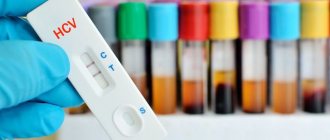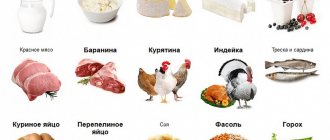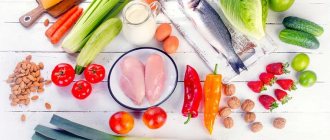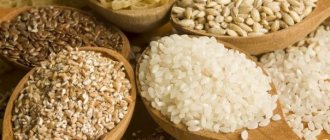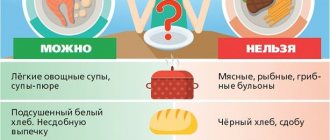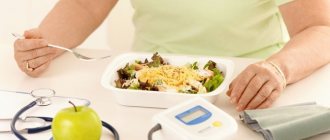The daily energy value is 3000-3400 kcal (proteins - 120 g, carbohydrates - 350-500 g, fats - 110 g).
- For breakfast - cottage cheese, oatmeal, tea.
For lunch - vegetable soups, fish, compote.
Recommendations for menu No. 12:
- The main principle is to exclude foods that excite the central nervous system.
It is recommended to exclude spicy foods, smoked foods, canned food, coffee and strong tea from your diet. To improve the functioning of the nervous system, foods containing B vitamins are prescribed. Daily energy value is 2300-2400 kcal (proteins - 80-90 g, carbohydrates - 350 g, fats - 70 g). - For breakfast it is better to choose buckwheat, fruit, juice.
- For lunch - soups with meat broth, steamed cutlets, vegetable stew.
- For dinner - vegetables, fish, compote.
Recommendations for menu No. 13:
- You can't go hungry. All foods must be boiled. Fried, spicy, fatty foods should be removed. Daily energy value - 2000-2100 kcal (proteins - 70 g, carbohydrates - 300 g, fats - 60-70 g).
- For breakfast - porridge, eggs, tea.
- For lunch - vegetable soups, steamed cutlets, juice.
- For dinner - meat, vegetables, compote.
Recommendations for menu No. 14:
- A nutritious diet includes foods that contain calcium (dairy products, fruits). Fatty, fried, spicy foods are removed. Daily energy value - 2600-2800 kcal (proteins - 90 g, carbohydrates - 350-400 g, fats - 100 g).
- For breakfast it is better to choose cereals, fruits, juice.
- For lunch - vegetable soups, fish, vegetable stew, tea.
- For dinner - meat, biscuits, jelly.
Recommendations for menu No. 15:
- This diet is prescribed when transitioning from all of the above diets. The range of products is varied, any heat treatment is allowed. Daily energy value - 2800-2900 kcal (proteins - 90-95 g, carbohydrates - 350-400 g, fats - 100 g).
- Porridge, eggs, tea are suitable for breakfast.
- For lunch - vegetable soups, fish, cereals, juice.
- For dinner - meat, porridge, vegetables, compote.
General rules
There is no doubt that good nutrition is the main component of a healthy lifestyle and human health in general.
Dietary nutritional therapy meets the physiological needs of the body and is adjusted depending on the course of the disease and the stage of the disease. Until 2003, the numbered diet system was based on a nosological principle (by disease), including 15 diets and numerous (up to 60) modifications. However, Table No. 1 , 5 , 7 , 9 and 15 . In 2003, a new nomenclature of diets was introduced, which for convenience combined the standard diets used in healthcare facilities and developed by M.I. Pevzner back in the 30s of the 20th century.
The new standard diet system includes:
- The main version of the standard diet (this is the decoding of the OVD) replaced the main therapeutic Tables according to Pevzner No. 1 , 2 , 3 , 5 , 6 , 7 , 9 , 10 , 13 , 14 , 15 , which do not require special restrictions on products. It is recommended for all healthy people to maintain health and for people suffering from gastrointestinal diseases in remission, acute febrile diseases and diseases of the cardiovascular system without circulatory disorders or with a minimal degree of disorders. In this regard, it is divided into: OVD1 (for diseases of the stomach with high acidity), OVD2 (diseases of the stomach with low acidity), OVD5 (diseases of the liver and biliary tract), OVD10 (cardiovascular system), etc. This diet is distinguished by its physiological content of proteins, fats, and carbohydrates. It is enriched with vitamins , minerals and plant fiber. The diet is 4-6 times a day, including snacks and fermented milk drinks at night. If you have diabetes, an adjustment is made: quickly absorbed carbohydrates are limited or eliminated, preference is given to foods with a low glycemic index. Patients should eat up to 5 times a day. This diet provides for the consumption of 85-90 g of protein (of which 40-45 g are animal), 70-80 g of fat (25-30 g of vegetable), 300-330 g of carbohydrates (simple - 30-40 g, which are excluded in case of sugar diabetes). The energy value of the therapeutic version of the diet is 2016-2400 kcal. When losing weight, reduce to 1500 kcal. The diet is limited to extractive substances (broths), salt (up to 8 g/day), spicy seasonings, smoked foods, as well as spinach and sorrel containing oxalic acid are excluded. Dishes are steamed, boiled or baked. The amount of liquid you drink is 1.5–2 liters per day.
- Option with mechanical and chemical sparing (includes Tables 1B , 4B , 4B , 5p ). Prescribed for gastrointestinal diseases. It is distinguished by the limitation of chemical (spicy, fried, extractive dishes) and mechanical irritants, so dishes are prepared exclusively by steaming or boiling; sometimes mashing or pureeing food is recommended.
- An option with a reduced protein content - a low protein diet (LPD) includes Tables 7A , 7B .
- With a high protein content - a high-protein diet (HPD), which includes Tables 4e , 4ag , 5p (second option), 7c , 37g , 9b , 10b .
- With reduced calorie content - a low-calorie diet (LCD) includes Tables 8 , 8A , 8o , 9A , 10C . Indicated for varying degrees of obesity without gastrointestinal complications. The diet provides for a moderate calorie restriction (1340-1550 kcal) due to fats (maximum 60 g in total) and the complete exclusion of easily digestible carbohydrates. It is enhanced by the content of plant fiber. Diet 5 times a day.
- With increased calorie content ( Table 11 ) for patients with tuberculosis - 3110-3640 kcal.
General characteristics of the OVD diet:
- It is balanced, so the feeling of hunger when doing it is eliminated.
- Designed for continuous adherence by healthy people and patients in remission.
- Contains healthy foods and a lot of fiber.
- Provides for fractional meals - 4 times or more when organizing snacks, which contributes to the rhythmic activity of the gastrointestinal tract.
- Involves preparing food by boiling, baking or steaming. These heat treatment methods do not involve the use of fats during cooking, so the food has a lower calorie content than fried food. In addition, it is easily absorbed and digested without disturbing the function of the digestive system.
- Excludes fatty and fried foods, extractive substances.
- Limits the consumption of simple carbohydrates and foods high in cholesterol.
The OVD diet, to summarize, is a healthy diet containing the physiological norm of all nutrients, aimed at maintaining a normal weight. If you want to lose weight, you will have to significantly increase physical activity and reduce caloric intake to 1500 kcal in your diet, or immediately choose an option with a reduced energy value, intended for obese patients .
Indications for use of the OVD diet
The OVD diet is used in the following cases:
- Chronic gastritis.
- Chronic stomach and intestinal ulcers.
- Chronic intestinal pathologies, accompanied by irritable bowel syndrome and constipation.
- Acute inflammation of the gallbladder.
- Acute hepatitis during the recovery stage.
- Chronic hepatitis (provided that the liver retains its functionality).
- Gout.
- Uric acid diathesis.
- Nephrolithiasis.
- Phosphaturia, hyperuricemia.
- Diabetes mellitus type 2 without obesity.
- Pathologies of the cardiovascular system, but without a pronounced disturbance in their functioning.
- IBS.
- Atherosclerotic lesions of the coronary arteries of the heart, brain and peripheral vessels.
- Infectious diseases in the acute stage.
- Fever.
Authorized Products
- Fish, steamed, boiled or baked.
- Lean meats and poultry prepared in the same way.
- Rye and wheat bread, flour products. These foods are limited when losing weight.
- Soups made from weak (secondary) broths or vegetable broths. To keep the diet varied, alternately include borscht, cabbage soup with fresh cabbage, rassolnik, various vegetable soups, beetroot soup (indicated for those prone to constipation ), and mushroom cereals. It is better to limit the consumption of the latter due to their higher calorie content.
- Any low-fat fermented milk drinks - yogurt, acidophilus, kefir, ayran, yogurt.
- Milk and sour cream for adding to dishes, cottage cheese 100-150 g per day, cheese 30 g.
- Boiled eggs or in the form of steamed, baked omelettes.
- Various cereals and pasta. They should be limited if you want to lose weight.
- Butter no more than 20 g, vegetable oils for seasoning dishes in the amount of 1-2 tbsp. l.
- Any vegetables according to tolerance. It's best to limit radishes, radishes, sorrel and spinach.
- Fresh fruits and berries in dishes (purees, mousses, jellies), compotes, juices, jelly and fruit drinks.
- Cocoa with water and milk, tea, coffee, rosehip infusion. According to the basic diet, sugar is allowed in the amount of 35 g per day. When losing weight, it is limited or eliminated.
Table of permitted products
| Proteins, g | Fats, g | Carbohydrates, g | Calories, kcal | |
Vegetables and greens | ||||
| zucchini | 0,6 | 0,3 | 4,6 | 24 |
| cabbage | 1,8 | 0,1 | 4,7 | 27 |
| cauliflower | 2,5 | 0,3 | 5,4 | 30 |
| carrot | 1,3 | 0,1 | 6,9 | 32 |
| cucumbers | 0,8 | 0,1 | 2,8 | 15 |
| beet | 1,5 | 0,1 | 8,8 | 40 |
| pumpkin | 1,3 | 0,3 | 7,7 | 28 |
Fruits | ||||
| apricots | 0,9 | 0,1 | 10,8 | 41 |
| oranges | 0,9 | 0,2 | 8,1 | 36 |
| watermelon | 0,6 | 0,1 | 5,8 | 25 |
| bananas | 1,5 | 0,2 | 21,8 | 95 |
| pears | 0,4 | 0,3 | 10,9 | 42 |
| melon | 0,6 | 0,3 | 7,4 | 33 |
| lime | 0,9 | 0,1 | 3,0 | 16 |
| lemons | 0,9 | 0,1 | 3,0 | 16 |
| tangerines | 0,8 | 0,2 | 7,5 | 33 |
| plums | 0,8 | 0,3 | 9,6 | 42 |
| apples | 0,4 | 0,4 | 9,8 | 47 |
Berries | ||||
| grape | 0,6 | 0,2 | 16,8 | 65 |
| strawberry | 0,8 | 0,4 | 7,5 | 41 |
| sea buckthorn | 1,2 | 5,4 | 5,7 | 82 |
| currant | 1,0 | 0,4 | 7,5 | 43 |
| rose hip | 1,6 | 0,0 | 14,0 | 51 |
Mushrooms | ||||
| mushrooms | 3,5 | 2,0 | 2,5 | 30 |
Nuts and dried fruits | ||||
| raisin | 2,9 | 0,6 | 66,0 | 264 |
| dates | 2,5 | 0,5 | 69,2 | 274 |
Cereals and porridges | ||||
| buckwheat (kernel) | 12,6 | 3,3 | 62,1 | 313 |
| cereals | 11,9 | 7,2 | 69,3 | 366 |
| corn grits | 8,3 | 1,2 | 75,0 | 337 |
| pearl barley | 9,3 | 1,1 | 73,7 | 320 |
| millet cereal | 11,5 | 3,3 | 69,3 | 348 |
| rice | 6,7 | 0,7 | 78,9 | 344 |
| barley grits | 10,4 | 1,3 | 66,3 | 324 |
Bakery products | ||||
| wheat bread | 8,1 | 1,0 | 48,8 | 242 |
| rye-wheat bread | 8,1 | 3,4 | 42,2 | 222 |
| Rye bread | 6,6 | 1,2 | 34,2 | 165 |
Raw materials and seasonings | ||||
| honey | 0,8 | 0,0 | 81,5 | 329 |
Dairy | ||||
| milk | 3,2 | 3,6 | 4,8 | 64 |
| kefir | 3,4 | 2,0 | 4,7 | 51 |
| sour cream | 2,8 | 20,0 | 3,2 | 206 |
| curdled milk | 2,9 | 2,5 | 4,1 | 53 |
| acidophilus | 2,8 | 3,2 | 3,8 | 57 |
| yogurt | 4,3 | 2,0 | 6,2 | 60 |
Cheeses and cottage cheese | ||||
| cheese | 24,1 | 29,5 | 0,3 | 363 |
| cottage cheese | 17,2 | 5,0 | 1,8 | 121 |
Meat products | ||||
| beef | 18,9 | 19,4 | 0,0 | 187 |
| veal | 19,7 | 1,2 | 0,0 | 90 |
| rabbit | 21,0 | 8,0 | 0,0 | 156 |
Bird | ||||
| chicken | 16,0 | 14,0 | 0,0 | 190 |
| turkey | 19,2 | 0,7 | 0,0 | 84 |
Eggs | ||||
| chicken eggs | 12,7 | 10,9 | 0,7 | 157 |
Oils and fats | ||||
| butter | 0,5 | 82,5 | 0,8 | 748 |
| corn oil | 0,0 | 99,9 | 0,0 | 899 |
| olive oil | 0,0 | 99,8 | 0,0 | 898 |
| sunflower oil | 0,0 | 99,9 | 0,0 | 899 |
Non-alcoholic drinks | ||||
| mineral water | 0,0 | 0,0 | 0,0 | — |
| lingonberry juice | 0,1 | 0,0 | 10,7 | 41 |
| green tea | 0,0 | 0,0 | 0,0 | — |
| black tea | 20,0 | 5,1 | 6,9 | 152 |
Juices and compotes | ||||
| compote | 0,5 | 0,0 | 19,5 | 81 |
| apricot juice | 0,9 | 0,1 | 9,0 | 38 |
| jelly | 0,2 | 0,0 | 16,7 | 68 |
| carrot juice | 1,1 | 0,1 | 6,4 | 28 |
| tomato juice | 1,1 | 0,2 | 3,8 | 21 |
| pumpkin juice | 0,0 | 0,0 | 9,0 | 38 |
| rose hip juice | 0,1 | 0,0 | 17,6 | 70 |
| * data is per 100 g of product | ||||
Features of diet table No. 9
The main task of the diet is to make the menu as healthy as possible and limit harmful fats and fast carbohydrates. The main instructions boil down to the following rules:
- They feed in small portions every 3 hours.
- 1 meal does not exceed 300 g.
- Calorie content – 23,000 kcal per day.
- The food is stewed and boiled, cooked in a double boiler.
- Drink more liquid – up to 2 liters per day.
- Avoid all sugar-containing products.
- The amount of salt is up to 12 g per day.
- Alcohol, salted foods, smoked foods, marinades, fried and spicy foods are prohibited.
- The main emphasis is on fresh fruits and vegetables, dairy products.
Normally, substances should be distributed as follows:
- protein – 100 g;
- carbohydrates – no more than 300 g (porridge, vegetables and fruits);
- fats – 80 g.
It is recommended to adhere to a certain energy value at each time of the day:
- 20% – after waking up;
- 10% – second breakfast;
- 30% – lunch meal;
- 10% – afternoon snack;
- 20% – evening;
- 10% - before bed.
In case of obesity, the daily calorie intake and the amount of carbohydrates can be reduced.
Fully or partially limited products
- Refractory fats, margarine, mayonnaise.
- Fatty meat broths.
- Fatty meat, poultry.
- Any fried food.
- Sausage, smoked meats, any canned food.
- Baking, sweets, jams, jams, sugar, ice cream, cakes and pastries are excluded when losing weight.
Table of prohibited products
| Proteins, g | Fats, g | Carbohydrates, g | Calories, kcal | |
Vegetables and greens | ||||
| canned vegetables | 1,5 | 0,2 | 5,5 | 30 |
| swede | 1,2 | 0,1 | 7,7 | 37 |
| canned cucumbers | 2,8 | 0,0 | 1,3 | 16 |
| radish | 1,2 | 0,1 | 3,4 | 19 |
| white radish | 1,4 | 0,0 | 4,1 | 21 |
| turnip | 1,5 | 0,1 | 6,2 | 30 |
| canned tomatoes | 1,1 | 0,1 | 3,5 | 20 |
| horseradish | 3,2 | 0,4 | 10,5 | 56 |
Confectionery | ||||
| cake | 3,8 | 22,6 | 47,0 | 397 |
Chocolate | ||||
| chocolate | 5,4 | 35,3 | 56,5 | 544 |
Raw materials and seasonings | ||||
| mustard | 5,7 | 6,4 | 22,0 | 162 |
| ketchup | 1,8 | 1,0 | 22,2 | 93 |
| mayonnaise | 2,4 | 67,0 | 3,9 | 627 |
| ground black pepper | 10,4 | 3,3 | 38,7 | 251 |
| sugar | 0,0 | 0,0 | 99,7 | 398 |
| vinegar | 0,0 | 0,0 | 5,0 | 20 |
Meat products | ||||
| pork | 16,0 | 21,6 | 0,0 | 259 |
Bird | ||||
| smoked chicken | 27,5 | 8,2 | 0,0 | 184 |
| duck | 16,5 | 61,2 | 0,0 | 346 |
| smoked duck | 19,0 | 28,4 | 0,0 | 337 |
| goose | 16,1 | 33,3 | 0,0 | 364 |
Fish and seafood | ||||
| smoked fish | 26,8 | 9,9 | 0,0 | 196 |
Oils and fats | ||||
| creamy margarine | 0,5 | 82,0 | 0,0 | 745 |
| animal fat | 0,0 | 99,7 | 0,0 | 897 |
| cooking fat | 0,0 | 99,7 | 0,0 | 897 |
| * data is per 100 g of product | ||||
Diet table 9 for pregnant women
Gestational diabetes may occur during pregnancy. It is usually caused by a decrease in cell sensitivity to insulin. After childbirth, the woman’s condition is restored, but there is a risk of developing diabetes in the future.
High blood sugar is dangerous for the mother and her baby. Therefore, it is important to monitor glucose concentrations and follow the table 9 diet, if prescribed by a doctor. The basic rules of the diet are the same:
- It is important to completely eliminate “fast” carbohydrates.
- It is necessary to eat food rich in fiber and vitamins.
- Pasta and potatoes are allowed in small quantities.
- Fried and fatty foods should be removed from the diet.
- You should buy yourself a glucometer and measure your sugar levels after meals throughout the day.
- Products are stewed and steamed.
Nutritional therapy is recommended for the next 2 months after birth. It will help avoid severe weight gain and normalize metabolism in the body. It is also important to consult an endocrinologist and periodically have your blood tested.
Menu (power mode)
There are several options for OVD with strictly taken into account calorie content and prescribed BZHU content. After studying all the examples, you can choose the seven-day menu that is most suitable for you and suits your taste. You can create your own diet for the week without using foods from the prohibited list.
The seven-day menu below for the main options for standard diets has a calorie content of 1500 to 1700 kcal on different days of the week, excluding the consumption of bread, butter and sugar. If you add 150 g of rye bread, 150 g of wheat, 20 g of butter and 35 g of sugar (7 teaspoons in all dishes), the energy value will increase by 830 kcal, which is significant for a person who is trying to lose weight. This menu takes into account all the necessary nutrients, the food is very varied and is organized 6 times a day.
If eating this menu is not accompanied by weight loss, you can reduce the consumption of carbohydrates (porridge, potatoes) and replace them with vegetable dishes. This way you will reduce the energy value of your diet.
| Breakfast |
|
| Lunch |
|
| Dinner |
|
| Afternoon snack |
|
| Dinner |
|
| For the night |
|
| Breakfast |
|
| Lunch |
|
| Dinner |
|
| Afternoon snack |
|
| Dinner |
|
| For the night |
|
| Breakfast |
|
| Lunch |
|
| Dinner |
|
| Afternoon snack |
|
| Dinner |
|
| For the night |
|
| Breakfast |
|
| Lunch |
|
| Dinner |
|
| Afternoon snack |
|
| Dinner |
|
| For the night |
|
| Breakfast |
|
| Lunch |
|
| Dinner |
|
| Afternoon snack |
|
| Dinner |
|
| For the night |
|
| Breakfast |
|
| Lunch |
|
| Dinner |
|
| Afternoon snack |
|
| Dinner |
|
| For the night |
|
| Breakfast |
|
| Lunch |
|
| Dinner |
|
| Afternoon snack |
|
| Dinner |
|
| For the night |
|
Recipes for various diets
Diet is not a reason to give up delicious food. You can prepare hearty meals for the whole family using permitted healthy foods.
For standard
A light vegetable salad will provide the body with fiber, minerals and vitamins.
To prepare it you need:
- 2-3 tomatoes;
- 1 red onion;
- fresh herbs (optional);
- 2 stalks of celery;
- 100 g soft low-fat cheese.
A light vegetable salad made from tomatoes will provide the body with vitamins.
Wash the vegetables and herbs, chop them, then add chopped cheese to them and mix. If desired, season with lemon juice and olive oil.
For breakfast you can make healthy sandwiches, for which you will need:
- rye bread;
- 100 g soft low-fat cottage cheese;
- garlic (1 clove);
- chopped fresh herbs (to taste).
Place the cheese in a bowl and mash with a fork. Add herbs, chopped garlic and mix. Spread the resulting mass onto rye bread.
For gentle
Soft, pureed dishes are suitable for this diet.
Curd pate will be useful. The list of required ingredients is as follows:
- 2 tbsp. low fat cottage cheese;
- 1 medium sized carrot;
- 1 tbsp. milk.
Low-fat cottage cheese is suitable for a gentle diet.
Boil the carrots, peel, finely grate, add cottage cheese and milk, mix all ingredients thoroughly. Wrap in cling film, giving the mixture a roll shape, and leave in the refrigerator for 1 hour. Warm the pate to room temperature before eating.
For the second course, chicken pate is suitable. First prepare the products:
- 1 tsp white rice;
- 1 medium carrot;
- 50 g chicken fillet;
- fresh herbs;
- 1 tbsp. butter.
Boil the meat and carrots, cut into small cubes. Boil rice cereal and strain. Mix all ingredients and pass through a meat grinder 2 times.
Mix the resulting mass with viscous rice water and butter.
For high protein
A nutritious steamed omelette is perfect for breakfast. First you need to prepare the ingredients:
- 3 egg whites;
- 200 g fresh baby spinach leaves;
- 30 ml milk;
- salt, pepper to taste.
Young spinach is suitable for breakfast.
Place egg whites in a bowl, add milk, spices, chopped spinach, mix thoroughly. Cook the omelette in a double boiler or microwave.
You can make delicious cheesecakes. The list of required products is as follows:
- 200 g of cottage cheese (it is better to take low fat);
- 1 chicken egg and 2 whites;
- 1 tbsp. oat bran;
- vanilla sugar and sweetener.
Mix all ingredients until a homogeneous mixture without lumps is obtained.
Spoon the cheesecakes out of the mixture, giving them a round shape, onto a baking sheet covered with parchment paper. Bake in the oven until fully cooked.
For low protein
This milk soup contains a small amount of protein, but will provide a long-lasting feeling of fullness.
You will need:
- 300 g of mixed vegetables (carrots, peas, onions, green beans, cauliflower);
- 2 liters of water;
- fresh herbs;
- 20 g butter;
- 80 ml cream.
Milk soup will provide a feeling of fullness.
Peel the vegetables, cut into small cubes, place in a saucepan, add water and cook until fully cooked. Then add cream and butter and keep on low heat for another 10-15 minutes. Before serving, garnish with chopped herbs.
Cutlets can be prepared not only from meat, but also from vegetables. For this dish prepare:
- 150 g onion;
- 1 egg white;
- 40 g oatmeal;
- spices to taste (pepper, paprika).
Peel the onion and cut into small cubes. Add egg whites beaten with spices and oatmeal ground in a coffee grinder. Leave the mixture for 15 minutes so that the cereal has time to swell. Form cutlets from the resulting minced meat. Cook in a steamer or oven.
For low calorie
You can start your morning with a low-calorie cocktail. You will need the following ingredients:
- 500 ml low-fat kefir;
- 30 g ginger root;
- 1 orange;
- 15 g cinnamon.
Peel the ginger, grate and squeeze out the juice. Peel the orange and squeeze it too. Mix the juices and pour into a blender. Add kefir and cinnamon to them. Beat the mixture. Before serving, garnish with a fresh mint sprig and grated orange zest.
Low-fat kefir is suitable for a low-calorie diet.
Zucchini pancakes contain a minimal amount of calories. The list of products is as follows:
- 2 medium zucchini or zucchini;
- 1 egg;
- 5 tbsp. oatmeal.
Wash the zucchini, finely grate and place in a deep bowl. Add spices to taste, egg and chopped oatmeal. Mix all ingredients. Form pancakes from the resulting minced meat and cook them in a non-stick frying pan with a minimum amount of vegetable oil.
Reviews and results
The main point of this diet is that it is balanced and contains the optimal calorie content for maintaining weight, and if it is reduced, for weight loss. Moreover, weight loss will occur slowly and without harm to health. This nutritional option is also suitable for overweight people with medical conditions. Strict adherence to all requirements will allow you to get rid of 500 g to 1 kg per week with increased physical activity. This rhythm of weight loss is the most optimal for losing weight.
- “... While staying in the sanatorium, I was on a similar diet. Only I didn’t eat pastries, sweets, I only took one piece of bread. At the same time, I ate porridge three times a day as a side dish for meat or fish. We were crushed by porridge - I don’t eat it three times a day at home, but there was no way out. There were also vegetable salads three times a day. I think that I ate normally and without any special restrictions. Imagine my surprise when, after 15 days, it turned out that the weight had decreased by 2 kg. I attribute this to the fact that the food was not fatty, and meat dishes were served boiled. All dishes were under-salted. I also went a lot (to the springs three times a day).”
- “... On such a diet I managed to lose 4 kg in a month. Yes, this is not much, but the important thing is that I did not feel hungry, I was cheerful and active. But to achieve such results, I ate porridge only once a day, sometimes twice, including milk. Potatoes were baked only 3 times in a month. For side dishes I used fresh or stewed vegetables, as well as various vegetable dishes. The diet was in the summer, so there was plenty of zucchini, eggplant, cucumbers, any greens, fruits (raspberries, currants, apricots). I made the juices myself. Of course, I excluded all unhealthy foods, and did not keep temptations in the form of sweets, cookies, and cakes in the house at this time. My conclusions: it’s easy to lose weight in the summer, eliminating fried foods helps, losing the first kilograms is easier - later I had to reconsider the diet and tighten it.”
Indications
Table 9 is practiced for the following diagnoses:
- bronchial asthma;
- rheumatism;
- hives;
- allergy;
- polyarthritis;
- diabetes mellitus type 2.
The patient’s nutrition is regulated depending on the disease and its neglect. Gender and age do not matter.
The diet allows you to:
- normalize sugar levels;
- reduce blood cholesterol;
- stabilize blood pressure;
- eliminate swelling.
Table 9 is allowed during pregnancy in case of gestational diabetes. The menu is developed by a therapist, endocrinologist and gynecologist.
NBD - therapeutic low protein diet
This table is intended primarily for those who suffer from acute kidney diseases, in particular renal failure. Its essence is to limit the consumption of protein foods, which, when processed by the kidneys, causes an increase in the level of acetone in the blood. NBD is indicated for patients with impaired functioning of the gallbladder and ducts, liver, pancreas, and with excessive accumulation of amino acids in the body.
Protein standards are usually prescribed by the attending physician, but they range from 0.6-0.7 grams per 1 kilogram of weight. Thus, it is permissible to consume approximately 40-55 grams per day on NBD. Small amounts of protein consumed should be completely natural, preferably of animal origin: meat, fish, milk, dairy products, cottage cheese, hard cheese. Completely excluded: fatty meat, smoked meats, offal, chocolate, soda and any alcohol, candy, nuts, seeds, beans, dried fruits, vermicelli, pasta and bread, semi-finished products, spices and herbs, coffee.
ShchD - gentle diet for weight loss
This therapeutic nutrition system was developed by nutritionists. Its main principle is fractional nutrition, with carefully chopped food and compliance with its temperature regime. It can be used for weight loss purposes, but was originally intended to relieve symptoms of the following diseases:
- Diarrhea.
- Acute intestinal diseases.
- Diseases of the stomach and pancreas.
- Pathologies of the kidneys and liver.
The consumption of sugar, spices, herbs, fat and oil is completely excluded, and you can’t eat any fried foods either. Products with emulsifiers, dyes, and flavor enhancers are not acceptable for ShchD.
Contraindications
Contraindications to the diet relate mainly to negative reactions to certain foods:
- fresh fruits should not be consumed by people with pathologies of the gastrointestinal tract or gallbladder;
- with increased blood clotting and a tendency to form blood clots, corn, carrots, green peas, apples and strawberries should be excluded;
- for pancreatitis, raw fruits and vegetables are prohibited;
- In case of increased stomach acidity, it is worth limiting the consumption of citrus fruits.
You cannot prescribe a therapeutic diet for yourself. In any case, competent consultation with a doctor is necessary.


